Key takeaways:
- Vintage fabrics are valued for their unique charm, craftsmanship, and sustainability, offering a connection to the past.
- Sourcing vintage fabrics can be done at thrift stores, flea markets, online marketplaces, and estate sales, each with its own treasures and stories.
- Incorporating vintage fabrics into modern designs can involve mixing patterns, deconstructing pieces, or using them as accents, enhancing originality and style.
- Styling tips include layering with modern pieces, embracing unique color palettes, and using vintage fabrics in accessories to create distinctive outfits.
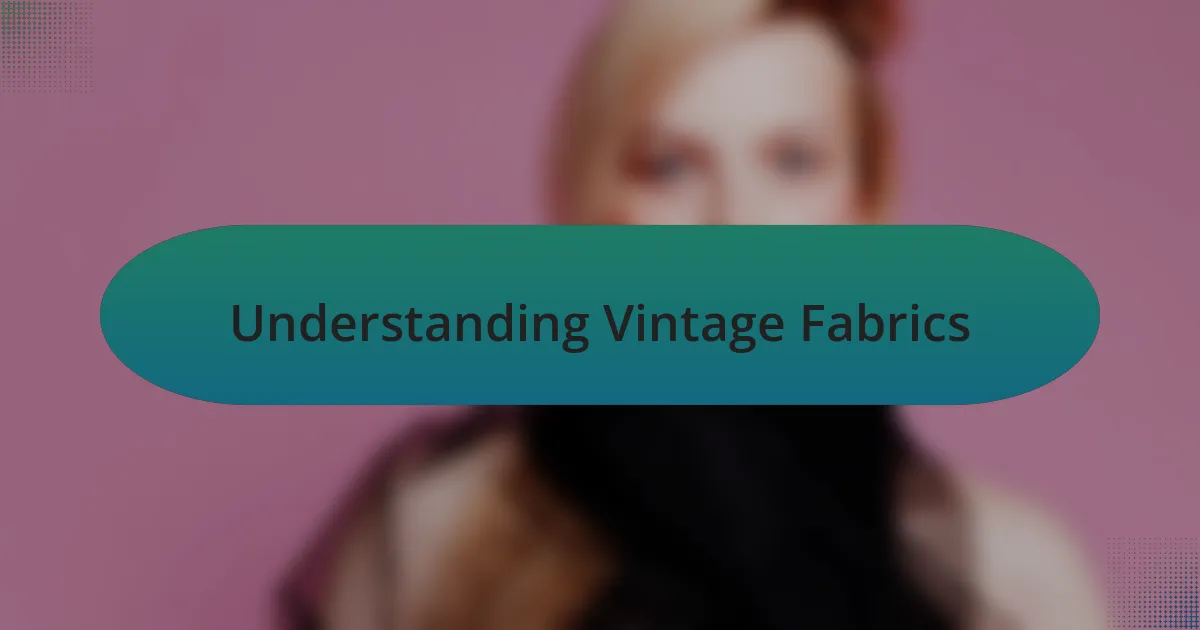
Understanding Vintage Fabrics
Vintage fabrics hold a unique charm that transcends time, inviting us to connect with the stories woven into them. I remember rummaging through a thrift store and coming across a worn-out piece of floral satin from the 1960s. The moment I touched it, I felt a wave of nostalgia, as if the fabric could whisper tales of the lives it had adorned.
Understanding vintage fabrics goes beyond their age; it involves recognizing the craftsmanship and materials that define them. For instance, silk taffeta from the 1950s has a crispness that modern substitutes often lack. This juxtaposition raises an interesting question: What experiences can you create from using a fabric that carries its own history?
When I incorporate vintage textiles into my designs, I often think about sustainability and originality. Each piece not only adds a distinctive flair to my creations but also supports a philosophy of reusing and repurposing. Isn’t it fascinating how a fabric can bring a touch of the past into a contemporary wardrobe?
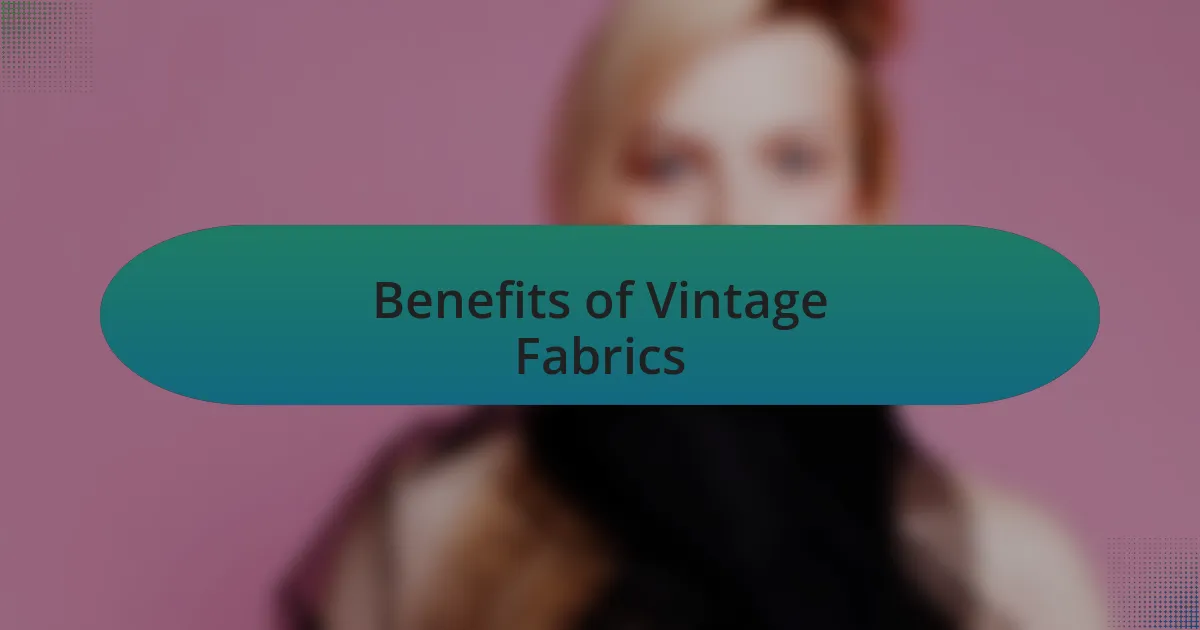
Benefits of Vintage Fabrics
Vintage fabrics offer a spectrum of benefits that can elevate any design piece. For me, their uniqueness creates a statement; I remember transforming a 1970s paisley print into a stunning dress that instantly became a conversation starter at a gathering. There’s something truly special about wearing a fabric that tells a story—it’s like donning a piece of history.
Sustainability is another core benefit I embrace when working with vintage textiles. By choosing to use these materials, I contribute to the reduction of waste in the fashion industry. I can’t help but feel a sense of pride when I reimagine a forgotten fabric into a modern outfit, knowing I’m helping to keep it out of landfills while promoting a more eco-conscious approach to fashion.
On top of that, the craftsmanship in vintage fabrics often surpasses what’s available today. I often find myself captivated by the intricate weaves and vibrant colors that are hard to replicate. Have you ever wondered how much care and expertise went into creating those patterns? It’s an invitation to celebrate the artistry of the past, ensuring that those traditions live on in our contemporary creations.
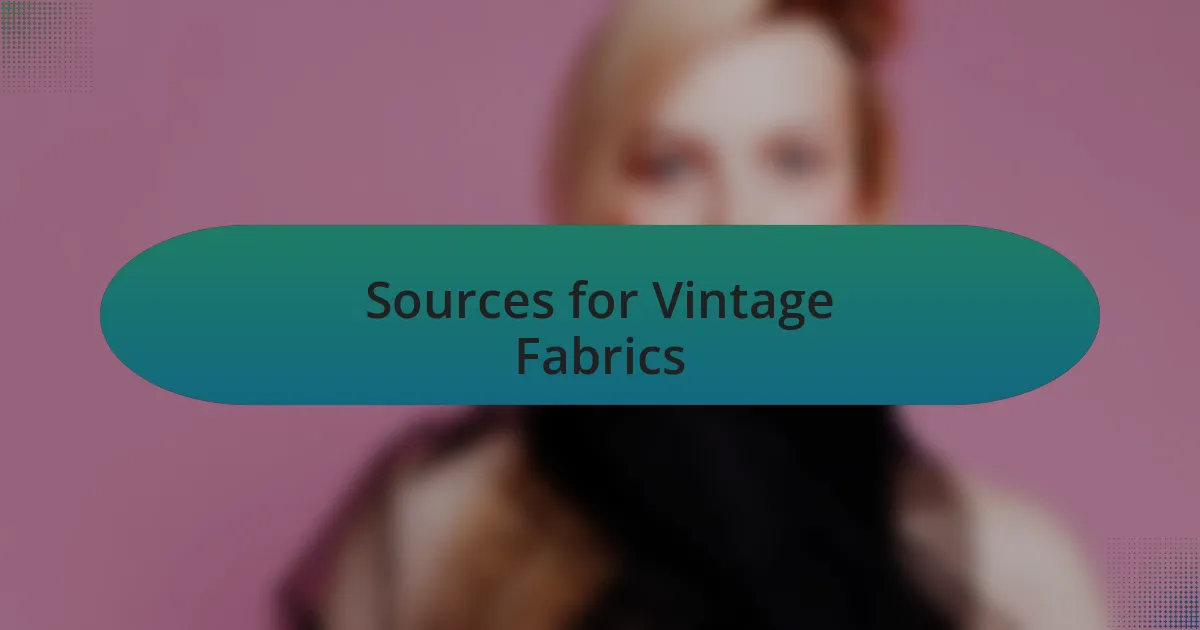
Sources for Vintage Fabrics
When I set out to find vintage fabrics, I often start my journey at thrift stores and flea markets. There’s an undeniable thrill in sifting through the racks, each piece potentially holding a story waiting to be uncovered. I remember once discovering a beautiful silk piece from the 1950s hidden beneath a pile of more modern fabrics—it felt like striking gold. These local spots often have hidden gems that contribute uniquely to any design.
Online marketplaces also offer a world of options for sourcing vintage fabrics. Websites like Etsy and eBay can be treasure troves—I once found a rolling bolt of floral cotton that instantly inspired a new collection for spring. It’s fascinating how a simple click can connect you to fabric from across the globe, bringing a piece of distant history right to your doorstep. Have you ever considered how online shopping widens the horizon of what you can source?
Local estate sales are another excellent and often-overlooked source. Walking through someone else’s preserved fabric stash feels intimate—it’s as though you’re participating in a mini time capsule. I once attended an estate sale where I not only bought an exquisite vintage feed sack but also heard stories from the owner’s daughter about how her mother used to sew quilts from it. That personal connection adds layers to the fabric that transform it from just material to a significant part of a new creation.
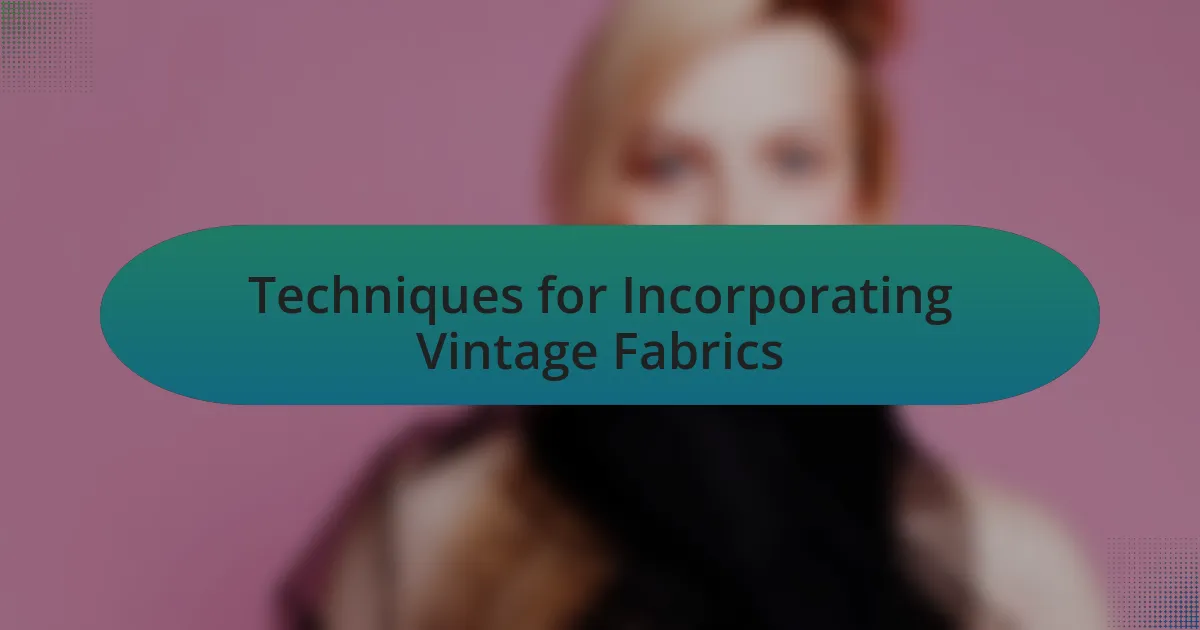
Techniques for Incorporating Vintage Fabrics
When I incorporate vintage fabrics into my designs, I often think about how to balance their character with contemporary styles. One technique I love is mixing patterns—like pairing a bold, retro print with a solid, modern piece. This creates a dynamic visual contrast that can make the vintage fabric stand out, almost like it’s telling a story amidst a more modern backdrop. Have you tried this approach? It truly breathes new life into the fabric.
Another method I’ve found effective is to deconstruct vintage pieces and repurpose them into new garments. There’s something exhilarating about cutting into a vintage dress and transforming it into a unique top or bag. I recall dismantling a faded floral skirt from the 60s and fashioning it into a playful sundress. The process not only respects the original fabric’s history, but it also allows for creative reinterpretation—turning the old into something fresh and relevant.
Lastly, I often use vintage fabrics as accents in my designs. For instance, I’ll create minimalist jackets and infuse them with cuffs or collars made from vibrant, patterned vintage textiles. It’s a subtle way to introduce a splash of history without overwhelming the overall look. I remember one particular jacket I made—it had a simple silhouette, but the vintage floral accents sparked so many compliments. It demonstrates how sometimes, less is more, and a single piece can make all the difference.
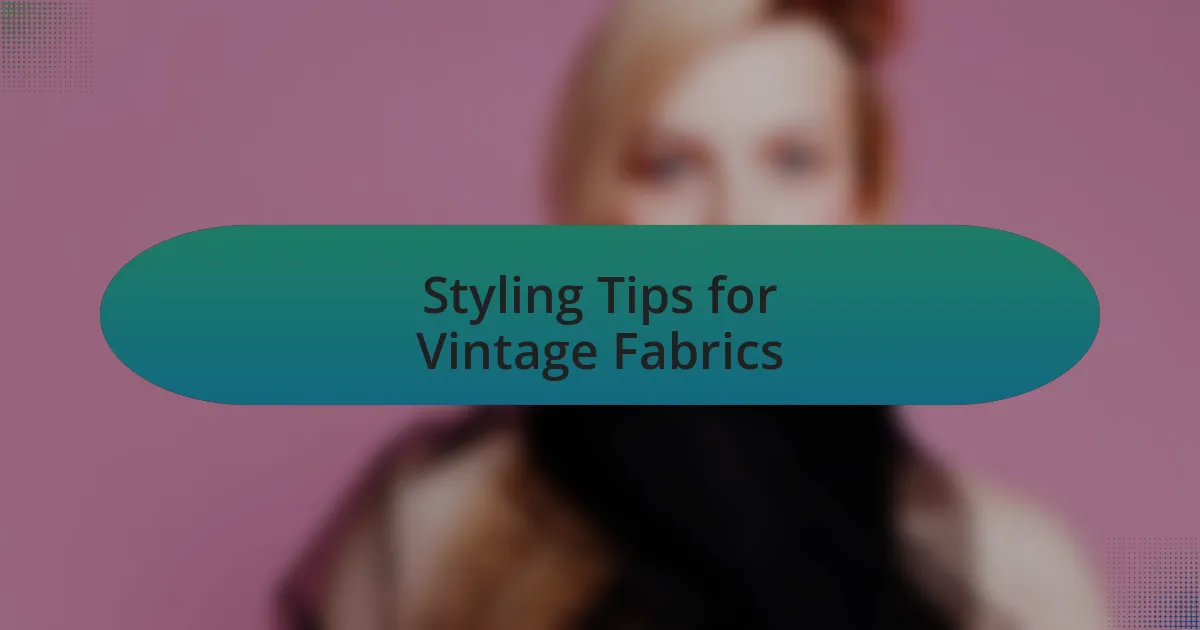
Styling Tips for Vintage Fabrics
When styling with vintage fabrics, I often gravitate toward layering to add depth and dimension to an outfit. For example, I love wearing a vintage blouse under a modern blazer; the soft texture of the fabric contrasts beautifully with the sharp lines of contemporary tailoring. It’s such a simple trick, but I feel it transforms the overall vibe, creating an effortlessly chic look. Have you considered what layering could do for your wardrobe?
Another approach I recommend is embracing the unique color palette of vintage textiles. I once came across a vibrant tapestry remnant that had an unexpected combination of shades—not your typical palette but incredibly stunning. Combining that fabric with neutral tones allowed the colors to pop while maintaining a cohesive style. It made me realize how these unexpected hues can turn heads and evoke curiosity about where the fabrics come from. Have any vintage pieces surprised you with their colors?
Finally, I find that incorporating vintage fabrics into accessories can be a game changer. I’ve created everything from headbands to clutches using remnants; they not only add personality to an outfit but also become conversation starters. I remember wearing a vintage fabric belt at a gathering, and everyone wanted to know where it was from. It’s a lovely way to celebrate the past while making a fashion statement in the present. Don’t you think accessories are the perfect way to express individual style?
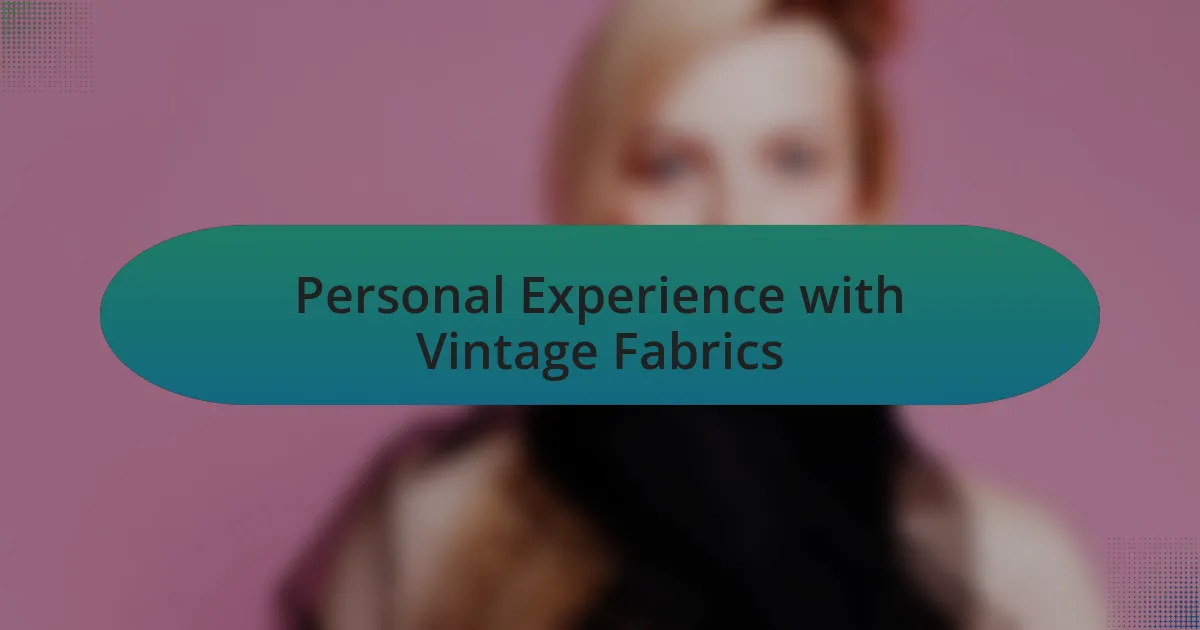
Personal Experience with Vintage Fabrics
Diving into vintage fabrics has been a transformative journey for me. I still remember the first time I discovered a stack of 1970s floral cotton at a thrift store. The moment I touched the fabric, I felt a rush of nostalgia, as if I was holding a piece of history. Have you ever felt a connection to an item just by its texture or pattern?
On another occasion, I stumbled upon a gorgeous silk scarf from the 1950s at a flea market. I hesitated for a moment, thinking about the price, but something about its intricate design and soft feel drew me in. Wearing that scarf transformed a simple outfit into something captivating. It reminded me that vintage pieces are not just clothes; they carry stories and emotions from the past. What stories might your own vintage finds hold?
I often reflect on the creative spark that vintage fabrics ignite within me. One evening, inspired by a beautiful 1960s paisley print, I decided to experiment and make a summery dress. The process was a blend of excitement and uncertainty as I navigated the unique characteristics of the fabric. When I finally wore my creation out, the compliments I received reminded me of how vintage textiles can truly enhance our self-expression. Isn’t it amazing how a simple piece of fabric can inspire creativity and boost confidence?